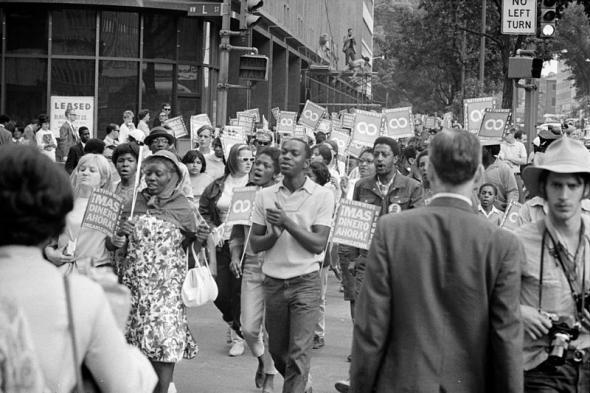This MLK Day weekend, I’ve been finishing up Jeanne Theoharis’ new book, A More Beautiful and Terrible History: The Uses and Misuses of Civil Rights History. Theoharis has written other mythbusting histories of civil rights, including the 2013 biography The Rebellious Life of Mrs. Rosa Parks. A More Beautiful and Terrible History is a synthesis of arguments Theoharis and other historians have made about the truncated and bloodless way the movement gets depicted in politics, culture, and public life.
The “things you didn’t learn in school” approach to correcting gaps in historical knowledge can be limiting for an author trying to make larger points about the way history works. But Theoharis doesn’t stop at pointing out omissions. She makes the forceful and persuasive argument that these “misuses” matter. They affect the way we understand racism in this country, and they diminish our appreciation of the activists who fought these battles.
And they’re everywhere! President Obama is far from immune.
Among the misconceptions Theoharis discusses…
Civil rights was a Southern fight. In places like New York, Boston, and Los Angeles, Theoharis shows, “nonviolent, disruptive struggles” for desegregation and reform took place starting well before the 1960s. This fact, Theoharis writes, has been proven by “an avalanche of scholarship over the past two decades,” yet public commemorations of civil rights continue to emphasize the movement’s Southern-ness. That approach allows Northerners to think of racism as a solvable aberration, limited to one particularly sick region of the country.
The movement’s late-1960s “turn” was tragic and sudden. Here’s how the mainstream narrative about the trajectory of civil rights activism goes: MLK was good, then the Civil Rights Act passed, and then the Black Panthers were bad. “The turn to Black Power is framed as inexplicable and ungrateful,” Theoharis writes. (She points to the 2013 Lee Daniels film The Butler as an example of a bit of culture that furthers this story.)
That interpretation depends on ignorance of the decades of patient organizing that preceded the Montgomery Bus Boycott, Theoharis argues. “The mounting militancy of the later 1960s didn’t come out of nowhere,” she writes. “It came from ignoring, denigrating, and rejecting the demands community organizers had made for years for real school desegregation and educational equity, open and affordable housing, jobs and a robust social safety net, equitable municipal services, and the transformation of the criminal justice system.”
Activists just wanted a seat on the bus/at the lunch counter. Our public fixation on two primal scenes of civil rights—Rosa Parks with her tired feet; stoic students wearing coats and ties at a Woolworth’s counter—obscures the real breadth of what the movement wanted, Theoharis argues. Refer to the list above, or to the author’s capsule histories of economic justice organizations like the Poor People’s Campaign and the National Welfare Rights Organization, or her discussion of the way the cases of Emmett Till and Jeremiah Reeves influenced activists to fight for criminal justice reform.
In retroactively narrowing the movement’s goals to access to public accommodations, Theoharis argues, we allow ourselves to think of the problem as “solved.” Reading about the goals of the campaign for economic justice makes it clear that this is far from true.
The movement was led by a few charismatic men. High-school junior Barbara Johns organized a strike in 1951 to protest the conditions at her all-black high school in Virginia. She and her student compatriots eventually brought their case to the Supreme Court, as part of Brown v. Board. But this was just the movement’s first student-led strike against inequitable education. Theoharis tells the story of later strikes in New York and Los Angeles, writing “Students fought back to show that they were not the problem but that the education they were being provided was—a lesson this country still wants to ignore.” The stories of these young people, as well as those of female activists like Coretta Scott King, Ella Baker, and Rosa Parks, show how broad and deep the movement truly was.
There’s a lot more in the book, including analyses of Northern media outlets’ failures to cover racism in their own cities; the story of civil rights activism in Los Angeles before Watts; and meditations on the lessons a true history of the movement can provide activists.
